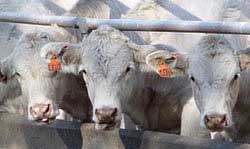Vermont's Conventional Dairy Farmers Pledge Not to Grow GMOs
Campaign for Moratorium on Genetically Engineered Crops Gaining Ground
For Immediate Release
January 21, 2004
Contact: Bayard Littlefield 802-272-9536
Drew Hudson 802-223-5221xt 4787
Montpelier, VT — 56 Vermont farmers urged legislators to support a "time out" on genetically engineered (GE) crops at the Vermont Statehouse today at a news conference and citizen lobby day. The Senate agriculture committee heard testimony from several conventional dairy farmers supporting a moratorium on GE crops. This grassroots advocacy effort came as today’s New York Times reported that a new study commissioned by the US Department of Agriculture says that "while there are many techniques being developed to prevent genetically engineered organisms or their genes from escaping into the wild, most techniques are still in early development and none appear to be completely effective."
70 Vermont towns have taken action at annual town meetings calling for policy at the local, state and national levels on genetically engineered agriculture to protect farmers and the environment. The Vermont Senate supported a bill last year calling for the labeling of genetically engineered seeds. Today conventional dairy farmers, citizens, environmental organizations and organic agriculture advocates gathered to again sound a warning about contamination of crops due to the use of GE varieties, and urge Vermont’s legislature to act.
"It is not just the organic farmers who are hurt by genetically engineered crops, it is the regular dairy farmer too—we want to see Vermont agriculture products stand for quality without this contamination," Dexter Randall, a 7th generation dairy farmer in Troy, Vermont said Wednesday. "Dairy farmers are coming out of the wood work to support not using GMOs across the state because they aren’t fooled by the tactics large corporations like Monsanto use to get them to buy and grow GE seed, " he added.
In 2004 alone, fifty -six conventional Vermont dairy farmers joined the growing national movement opposed to GE crops by pledging not to grow the corporate seeds. Farmers in rural Vermont, across the Midwest, and around the country are concerned about pollen drift and liability for contaminated crops.
Late last year, the Vermont Public Interest Research Group (VPIRG) found that samples of organic corn from Vermont fields did in fact yield traces of genetically engineered material, proving that containment of these new crops is not adequate to protect farmers from contamination. Vermont Governor Jim Douglas and his administration are proposing to send a letter to farmers encouraging them to talk to their neighbors about GMOs as the state’s policy to deal with the contamination crisis. But today local farmers reiterated that what’s needed is a "Time Out on GMOs."
The GE Free Vermont Campaign on Genetic Engineering is a statewide coalition of public interest groups, businesses, concerned citizens and farmers, who are organizing to oppose genetic engineering at the local, state and national level, and calling for a "Time Out" on GMOs.


